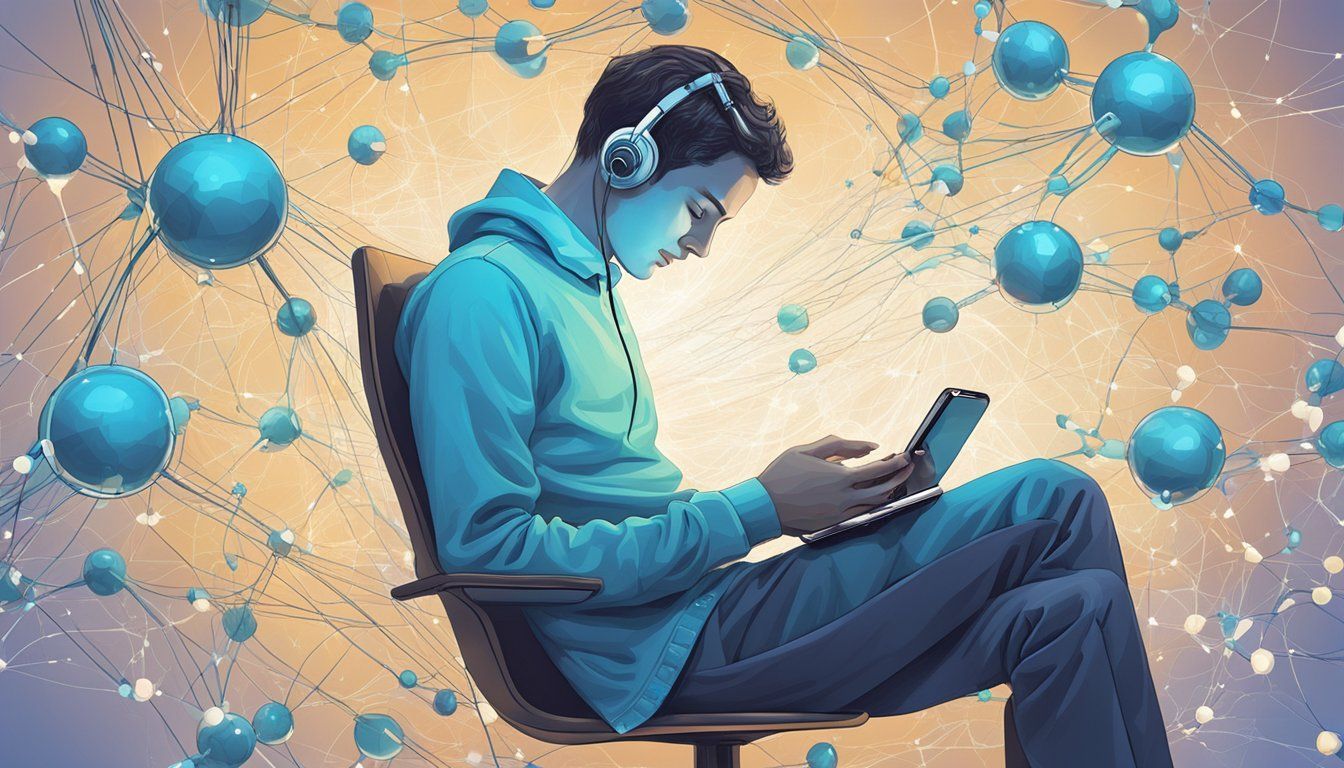Doomscrolling and the Science of Algorithmic Dopamine Addiction: Understanding the Impact
Scrolling through your favorite social media feed can be hard to resist, especially so with negatively provocative content. Over-exposure to this type of algorithmic content can trigger a powerful form of compulsive behaviour, one which taps directly into several deep-rooted biological mechanisms. Known as
Doomscrolling, it triggers the release of dopamine in the brain, making it an addictive physiological cycle that is hard to break. Algorithms on social media platforms are specifically designed to keep users' eyes on their screens as long as possible by providing endless streams of highly targeted content, which in certain cases can significantly contribute to this phenomenon.

The term “doomscrolling” became popular during the COVID-19 pandemic, but the behavior existed long before that. As people seek out new and novel information, their dopamine levels spike, creating a feeling of pleasure and reward. Unfortunately, this can also lead to increased feelings of anxiety and depression, as negative news often dominates these feeds.
Breaking free from this cycle requires an understanding of the psychology behind it. Social media algorithms continuously feed similar types of content, reinforcing the addiction. Understanding the mental mechanisms at play can empower individuals to take control and develop healthier habits.
Key Takeaways
- Doomscrolling is driven by dopamine release and social media algorithms.
- Compulsive scrolling can increase anxiety and depression.
- Understanding the science can help develop healthier online habits.
Understanding Doomscrolling

Doomscrolling involves spending excessive time on devices, consuming negative news. It is influenced by factors like the brain’s dopamine response, technology, and major events like the Covid-19 pandemic.
Defining the Phenomenon
Doomscrolling refers to the act of endlessly scrolling through bad news on social media and news websites. This behavior creates a cycle where a person is drawn to negative information. Social media platforms and news apps are designed to keep users engaged, which leads to excessive scrolling.
The term gained popularity during the Covid-19 pandemic, though it existed before. People often feel compelled to keep reading more negative news, seeking to understand threats but ending up feeling anxious and stressed instead.
Psychology Behind Doomscrolling
The psychology behind doomscrolling is complex. It involves the brain’s reward system, particularly dopamine. Novel and fear-inducing information triggers a dopamine release, making doomscrolling feel rewarding, even addictive.
Technology and social media platforms exploit this by showing content that keeps users hooked. The more negative or sensational the news, the more likely someone is to continue scrolling. This behavior feeds anxiety and stress, as constant exposure to negative information affects mental health.
Impact of the Covid-19 Pandemic
The Covid-19 pandemic intensified doomscrolling for many people. With widespread uncertainty and fear, individuals turned to news and social media for updates. This constant influx of negative news worsened stress and anxiety levels.
Before the pandemic, doomsurfing and mindless scrolling were common, but the global crisis amplified the behavior. People felt a strong need to stay informed about the evolving situation, leading to more frequent and prolonged sessions of consuming distressing news. This has had lasting effects on mental health for many.
The Role of Technology
The role of technology in doomscrolling is significant. Algorithms, device integration, and feedback loops all play a part in keeping users engaged and impacting their mental health.
Algorithm Influence
Algorithms tailor content to keep users engaged. They analyze user behavior, like clicks, likes, and screen time, to suggest more of what grabs attention. This keeps people scrolling for hours.
These algorithms often prioritize emotionally charged content, which is more likely to elicit a dopamine response. Negative news and sensational stories get more engagement, making them appear more frequently.
By constantly adjusting to user preferences, algorithms create a personalized stream of content that can be hard to put down.
Smartphone and Social Media Integration
Smartphones make it easy to access social media at any time. Notifications alert users to new content, often pulling them back into endless scrolling. Features like infinite scroll make it easy to keep going without noticing the passage of time.
Social media platforms are designed to be addictive. They use bright colors, likes, and shares to make interactions more appealing. This integration of technology into daily life means people can doomscroll anytime and anywhere.
The convenience of smartphones amplifies the problem, making it a constant presence for many users.
Feedback Loops and Reward System
Doomscrolling taps into the brain’s reward system. Viewing new content releases dopamine, reinforcing the behavior. The unpredictable nature of social media—where users don’t know what they’ll see next—keeps them coming back for more.
Feedback loops play a crucial role. Engagement metrics like likes, comments, and shares provide constant feedback, encouraging users to keep engaging. Each interaction can give a small dopamine hit, making social media use feel rewarding.
These loops are designed to be addictive, making it a challenge to break the cycle of doomscrolling.
Psychological Impacts

Doomscrolling can significantly impact mental health and stress levels. The constant exposure to negative news affects brain chemistry and emotional well-being, leading to various negative outcomes.
Emotional and Mental Health Consequences
Reading negative news repeatedly can harm one’s emotional well-being. Exposure to distressing content can increase feelings of depression and anxiety . People might notice a drop in their self-esteem after consuming such content.
Negative news triggers a cycle of worry, making it hard to relax. The more time people spend on social media reading bad news, the worse they can feel emotionally and mentally. Connections between doomscrolling and life satisfaction show that constantly focusing on bad news can reduce overall happiness.
Acute Stress Response and Brain Chemistry
Doomscrolling affects brain chemistry by increasing stress hormones like cortisol . Continuous exposure to distressing news activates the brain’s stress response, leading to higher levels of cortisol. This can result in sleep disturbances and other stress-related issues.
Dopamine release, often associated with pleasure, can also occur during doomscrolling. Engaging with new and alarming content satisfies curiosity , causing a temporary dopamine spike. However, this short-term reward doesn’t balance the long-term consequences on mental health, making it a challenging cycle to break out of.
These brain chemistry changes can significantly affect emotional well-being and mental health , leading to persistent stress and anxiety. Repeated activation of these responses can cause chronic stress, affecting one’s overall mental state and daily functioning.
Behavioral Aspects

Behavioral aspects of doomscrolling involve compulsive behaviors and the impact of personality traits. These behaviors are often reinforced by algorithmic systems and can vary based on individual vulnerabilities.
Compulsive Behaviors and Habit Formation
Doomscrolling leads to compulsive behavior where users continuously scroll through negative news. This behavior is driven by the dopamine rush from consuming novel information, which strengthens the habit. The pandemic saw an increase in this behavior, though it existed before COVID-19.
Algorithms play a key role by feeding users an endless stream of content. This constant supply of information makes it easy to lose track of time while scrolling. Dopamine, a neurotransmitter essential for pleasure and reward, reinforces this habit. It makes the cycle of repeated scrolling difficult to break.
Habit formation occurs because of repeated exposure to these dopamine hits. Over time, this can lead to a learned behavior where individuals seek out negative information. The cycle continues, making it challenging for many to stop scrolling even when they recognize its harmful effects.
Personality Traits and Vulnerability
Individuals with certain personality traits may be more prone to doomscrolling. Traits such as high neuroticism, anxiety, or a tendency toward negative thinking can increase vulnerability. People with these traits might find it harder to resist the urge to scroll.
Personality also affects how people react to negative information. Some may feel compelled to keep scrolling in an attempt to seek out more information and understand crises better. Others may have difficulty controlling the impulse due to a lack of self-regulation.
Research suggests that those with lower emotional stability are more likely to engage in doomscrolling. The constant exposure to distressing news can exacerbate these traits, creating a feedback loop that makes the habit more entrenched.
Frequently Asked Questions
Doomscrolling significantly affects mental health and can lead to digital addiction. Dopamine plays a crucial role in why people engage in this habit. Understanding who is most vulnerable and how widespread this behavior is can help in finding ways to mitigate its effects.
What are the psychological impacts of doomscrolling on mental health?
Doomscrolling can lead to increased feelings of anxiety and depression. Studies suggest that consuming negative content regularly can leave individuals feeling more exhausted and sad. This habit can take a toll on mental well-being, causing a constant state of worry and stress.
How does doomscrolling contribute to the cycle of digital addiction?
The constant flow of negative news can make it hard to stop scrolling. People often feel the need to stay updated, which keeps them hooked for longer periods. This creates a cycle where the temporary relief of curiosity leads to more scrolling, feeding the addiction.
What methods can be employed to mitigate the effects of doomscrolling?
Setting time limits for social media use can help manage doomscrolling. Replacing this habit with engaging in positive activities such as physical exercise or hobbies can also make a difference. Mindfulness practices like meditation can aid in reducing the urge to continually check for negative news.
In what ways does dopamine influence our propensity to engage in doomscrolling?
Dopamine is a neurotransmitter that makes us feel rewarded. Even when consuming negative content, dopamine gets released, encouraging the habit. This release happens because our brain is wired to be curious and seeks information, making it hard to break the cycle of doomscrolling.
What demographic is most susceptible to the habit of doomscrolling?
Younger adults and teens are more susceptible to doomscrolling. They tend to spend more time on social media platforms and are more likely to encounter and engage with negative content. This group can be more affected by the psychological impacts of continuous negative news consumption.
How prevalent is the phenomenon of doomscrolling in the general population?
Doomscrolling has become increasingly common, especially with the rise of social media and 24-hour news cycles. Many people report spending excessive amounts of time consuming negative content. It has become a notable behavior pattern, particularly during times of crisis or global events.
Building better solutions for better business®




